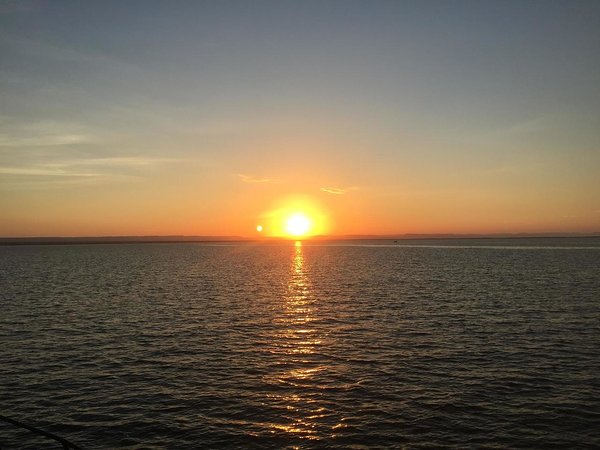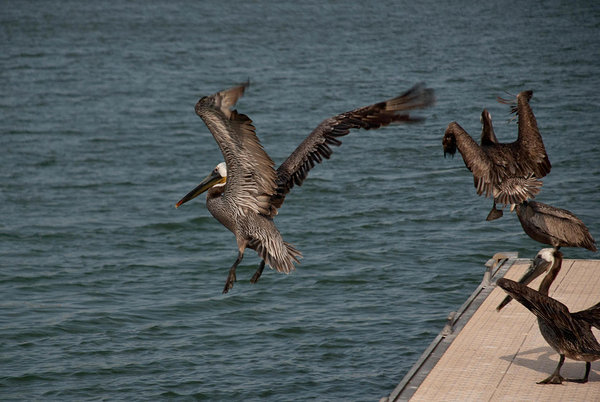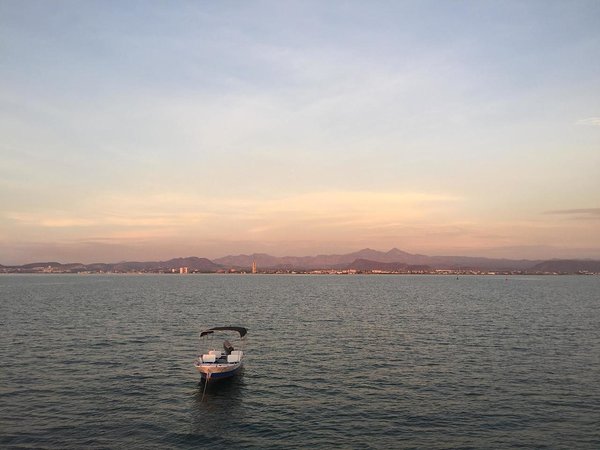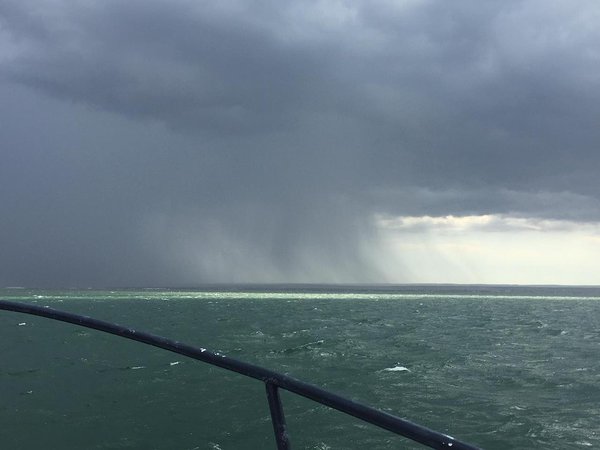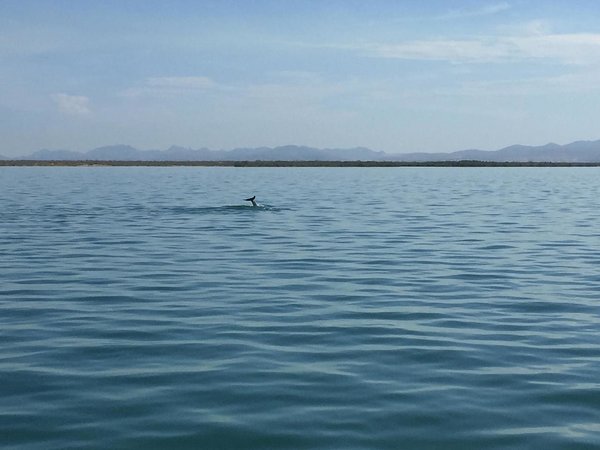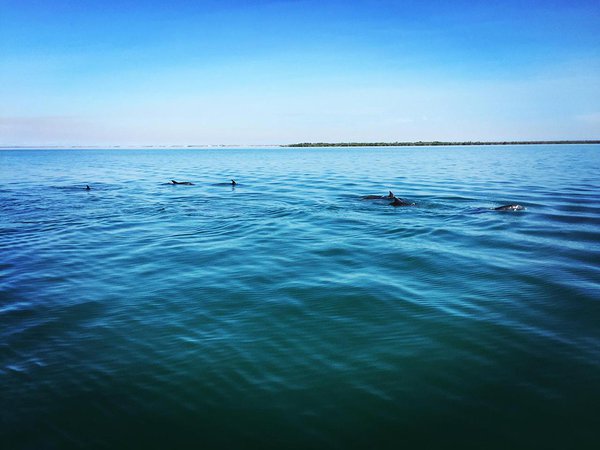Sunsets and Pelican Rush Hour,
We spent the last week anchored out by the mogote, it was defined by dolphins, pelicans, sunsets and time reconnecting with nature.
Its 7:45pm and as the sun dips below the horizon, we say goodbye to the end of one day and welcome the break before the start of the next one. It is about this same time that we see the pelicans. Its like they are also finishing their day and all heading home on their evening commute, so regular and coordinated is their passing. They come in three waves with about 10-15 in each group. Skimming low to the water but never touching it they look like graceful pterodactyls, a remnant from days gone by.
Pelicans are funny looking birds, to me they look like dinosaurs with their long beaks and scaly throat pouches. They are quite comical to watch because they seem so graceful in flight and then bam, they crash onto the water like they just did a big belly flop! In reality there is method to their madness, as they plunge into the water, the impact of their bodies stuns small fish so that they can scoop them up in their expandable throat pouches. When the pelicans drop out of the sky to hit the water, it is not without some consideration and special adaptations, pelicans have special air sacs beneath the skin in their breasts which act as cushions to break the force of impact with the water. Also if you watch them carefully you will notice that they rotate their body a little to the left. By doing this they help to protect their trachea during the dive. After a dive you will often see them open and close their mouth to drain out the water. As a bird that lives here in Baja year round it is well adapted to the desert climate, having a specialised salt gland that helps it to survive by being able to tolerate drinking saltwater.
Pelicans aren't the only birds we would see during our time by the mogote, the magnificent frigate bird was a frequent visitor as were oyster catchers, ospreys and herons. It was a calm and tranquil way to spend the evenings. So why do they like the Mogote? Well the mogote is a sandy barrier that forms it own peninsula across the Bay of La Paz, it is attached to the Baja at one very arrow point and it supports a number f different ecosystems including mangroves and sand dunes. It also acts as a natural breakwater for the Bay of La Paz (and as I am writing this post during a Tropical Storm - more on that another time) I am very glad to have this natural resource nearby.
The mogote is also important for helping to create the right habitat for the whale sharks that visit La Paz (see last weeks post for more information). Mangroves create a great habitat for many bird species in this area as they provide a nursery for small fish therefore food supply is plentiful, they are also a good home for invertebrate life such as crabs which again is good for the birds to feed on. Mangroves are specialised plants and one of only a few species which can survive in anoxic, saltwater environments. They are called halophytes as they are tolerant to this salty conditions, this is because they have a specialised filtration system to deal with the salt and also an adapted root system to allow them to survive in a waterlogged and low oxygen environment. Red mangroves are the most abundant around the mogote and they are identified by their prop roots - these are ones that come above ground and make the plant look like it is walking or tiptoeing along. The mangreoves here is Baja stay relatively small due to the arid climate and don't reach more that a few meters in height but they can grow over 20m! We also find black and white mangroves here in Baja. Black mangroves deal with excess salt by having sacrificial leaves that collect salt and then are dropped off. White mangroves are unique because they give birth to live young! (It conjures up images of a mangrove tree going into labour!) They show vivipary; this means that the seeds germinate whilst still attached to the parent. When they are ready these propagules drop off and drift with the sea currents, when they reach land they are ready to drop their roots and take hold.
Norman and I decided to spend some time out of the marina yet close to La Paz for work and errand running to allow us to appreciate the area that we live in and reset after a busy summer. Being able to surround ourselves with nature including daily dolphin visits, schools of fish, turtles, birdlife a plenty and yet only being 10 minutes from the marina was a luxury that we fully enjoyed. It wasn't all sun and games we did get to experience an afternoon torritos and we trust that our anchor holds well with that and also the night time corumel winds. There is always something going on here in Baja that requires our attention but we are happy to have made the change in our lives that allows us to be here to experience these things. We look forward to sharing them with you too.
Pelicans are funny looking birds, to me they look like dinosaurs with their long beaks and scaly throat pouches. They are quite comical to watch because they seem so graceful in flight and then bam, they crash onto the water like they just did a big belly flop! In reality there is method to their madness, as they plunge into the water, the impact of their bodies stuns small fish so that they can scoop them up in their expandable throat pouches. When the pelicans drop out of the sky to hit the water, it is not without some consideration and special adaptations, pelicans have special air sacs beneath the skin in their breasts which act as cushions to break the force of impact with the water. Also if you watch them carefully you will notice that they rotate their body a little to the left. By doing this they help to protect their trachea during the dive. After a dive you will often see them open and close their mouth to drain out the water. As a bird that lives here in Baja year round it is well adapted to the desert climate, having a specialised salt gland that helps it to survive by being able to tolerate drinking saltwater.
Pelicans aren't the only birds we would see during our time by the mogote, the magnificent frigate bird was a frequent visitor as were oyster catchers, ospreys and herons. It was a calm and tranquil way to spend the evenings. So why do they like the Mogote? Well the mogote is a sandy barrier that forms it own peninsula across the Bay of La Paz, it is attached to the Baja at one very arrow point and it supports a number f different ecosystems including mangroves and sand dunes. It also acts as a natural breakwater for the Bay of La Paz (and as I am writing this post during a Tropical Storm - more on that another time) I am very glad to have this natural resource nearby.
The mogote is also important for helping to create the right habitat for the whale sharks that visit La Paz (see last weeks post for more information). Mangroves create a great habitat for many bird species in this area as they provide a nursery for small fish therefore food supply is plentiful, they are also a good home for invertebrate life such as crabs which again is good for the birds to feed on. Mangroves are specialised plants and one of only a few species which can survive in anoxic, saltwater environments. They are called halophytes as they are tolerant to this salty conditions, this is because they have a specialised filtration system to deal with the salt and also an adapted root system to allow them to survive in a waterlogged and low oxygen environment. Red mangroves are the most abundant around the mogote and they are identified by their prop roots - these are ones that come above ground and make the plant look like it is walking or tiptoeing along. The mangreoves here is Baja stay relatively small due to the arid climate and don't reach more that a few meters in height but they can grow over 20m! We also find black and white mangroves here in Baja. Black mangroves deal with excess salt by having sacrificial leaves that collect salt and then are dropped off. White mangroves are unique because they give birth to live young! (It conjures up images of a mangrove tree going into labour!) They show vivipary; this means that the seeds germinate whilst still attached to the parent. When they are ready these propagules drop off and drift with the sea currents, when they reach land they are ready to drop their roots and take hold.
Norman and I decided to spend some time out of the marina yet close to La Paz for work and errand running to allow us to appreciate the area that we live in and reset after a busy summer. Being able to surround ourselves with nature including daily dolphin visits, schools of fish, turtles, birdlife a plenty and yet only being 10 minutes from the marina was a luxury that we fully enjoyed. It wasn't all sun and games we did get to experience an afternoon torritos and we trust that our anchor holds well with that and also the night time corumel winds. There is always something going on here in Baja that requires our attention but we are happy to have made the change in our lives that allows us to be here to experience these things. We look forward to sharing them with you too.
